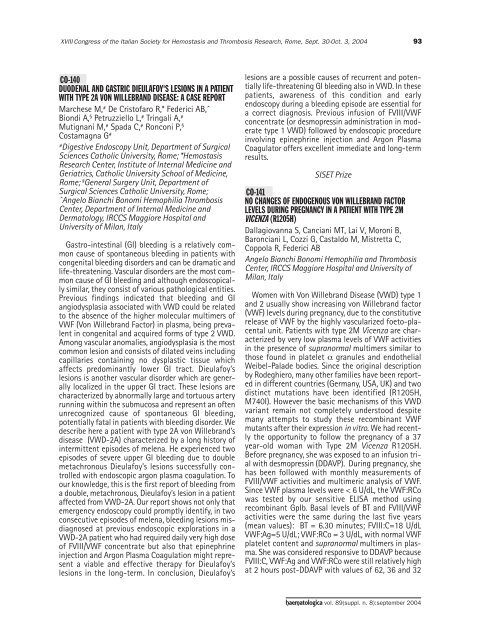Haematologica 2004;89: supplement no. 8 - Supplements ...
Haematologica 2004;89: supplement no. 8 - Supplements ...
Haematologica 2004;89: supplement no. 8 - Supplements ...
- No tags were found...
Create successful ePaper yourself
Turn your PDF publications into a flip-book with our unique Google optimized e-Paper software.
XVIII Congress of the Italian Society for Hemostasis and Thrombosis Research, Rome, Sept. 30-Oct. 3, <strong>2004</strong>93CO-140DUODENAL AND GASTRIC DIEULAFOY'S LESIONS IN A PATIENTWITH TYPE 2A VON WILLEBRAND DISEASE: A CASE REPORTMarchese M, # De Cristofaro R,* Federici AB,^Biondi A, § Petruzziello L, # Tringali A, #Mutignani M, # Spada C, # Ronconi P, §Costamagna G ##Digestive Endoscopy Unit, Department of SurgicalSciences Catholic University, Rome; *HemostasisResearch Center, Institute of Internal Medicine andGeriatrics, Catholic University School of Medicine,Rome; § General Surgery Unit, Department ofSurgical Sciences Catholic University, Rome;^Angelo Bianchi Bo<strong>no</strong>mi Hemophilia ThrombosisCenter, Department of Internal Medicine andDermatology, IRCCS Maggiore Hospital andUniversity of Milan, ItalyGastro-intestinal (GI) bleeding is a relatively commoncause of spontaneous bleeding in patients withcongenital bleeding disorders and can be dramatic andlife-threatening. Vascular disorders are the most commoncause of GI bleeding and although endoscopicallysimilar, they consist of various pathological entities.Previous findings indicated that bleeding and GIangiodysplasia associated with VWD could be relatedto the absence of the higher molecular multimers ofVWF (Von Willebrand Factor) in plasma, being prevalentin congenital and acquired forms of type 2 VWD.Among vascular a<strong>no</strong>malies, angiodysplasia is the mostcommon lesion and consists of dilated veins includingcapillaries containing <strong>no</strong> dysplastic tissue whichaffects predominantly lower GI tract. Dieulafoy’slesions is a<strong>no</strong>ther vascular disorder which are generallylocalized in the upper GI tract. These lesions arecharacterized by ab<strong>no</strong>rmally large and tortuous arteryrunning within the submucosa and represent an oftenunrecognized cause of spontaneous GI bleeding,potentially fatal in patients with bleeding disorder. Wedescribe here a patient with type 2A von Willebrand’sdisease (VWD-2A) characterized by a long history ofintermittent episodes of melena. He experienced twoepisodes of severe upper GI bleeding due to doublemetachro<strong>no</strong>us Dieulafoy’s lesions successfully controlledwith endoscopic argon plasma coagulation. Toour k<strong>no</strong>wledge, this is the first report of bleeding froma double, metachro<strong>no</strong>us, Dieulafoy’s lesion in a patientaffected from VWD-2A. Our report shows <strong>no</strong>t only thatemergency endoscopy could promptly identify, in twoconsecutive episodes of melena, bleeding lesions misdiag<strong>no</strong>sedat previous endoscopic explorations in aVWD-2A patient who had required daily very high doseof FVIII/VWF concentrate but also that epinephrineinjection and Argon Plasma Coagulation might representa viable and effective therapy for Dieulafoy’slesions in the long-term. In conclusion, Dieulafoy’slesions are a possible causes of recurrent and potentiallylife-threatening GI bleeding also in VWD. In thesepatients, awareness of this condition and earlyendoscopy during a bleeding episode are essential fora correct diag<strong>no</strong>sis. Previous infusion of FVIII/VWFconcentrate (or desmopressin administration in moderatetype 1 VWD) followed by endoscopic procedureinvolving epinephrine injection and Argon PlasmaCoagulator offers excellent immediate and long-termresults.SISET PrizeCO-141NO CHANGES OF ENDOGENOUS VON WILLEBRAND FACTORLEVELS DURING PREGNANCY IN A PATIENT WITH TYPE 2MVICENZA (R1205H)Dallagiovanna S, Canciani MT, Lai V, Moroni B,Baronciani L, Cozzi G, Castaldo M, Mistretta C,Coppola R, Federici ABAngelo Bianchi Bo<strong>no</strong>mi Hemophilia and ThrombosisCenter, IRCCS Maggiore Hospital and University ofMilan, ItalyWomen with Von Willebrand Disease (VWD) type 1and 2 usually show increasing von Willebrand factor(VWF) levels during pregnancy, due to the constitutiverelease of VWF by the highly vascularized foeto-placentalunit. Patients with type 2M Vicenza are characterizedby very low plasma levels of VWF activitiesin the presence of supra<strong>no</strong>rmal multimers similar tothose found in platelet α granules and endothelialWeibel-Palade bodies. Since the original descriptionby Rodeghiero, many other families have been reportedin different countries (Germany, USA, UK) and twodistinct mutations have been identified (R1205H,M740I). However the basic mechanisms of this VWDvariant remain <strong>no</strong>t completely understood despitemany attempts to study these recombinant VWFmutants after their expression in vitro. We had recentlythe opportunity to follow the pregnancy of a 37year-old woman with Type 2M Vicenza R1205H.Before pregnancy, she was exposed to an infusion trialwith desmopressin (DDAVP). During pregnancy, shehas been followed with monthly measurements ofFVIII/VWF activities and multimeric analysis of VWF.Since VWF plasma levels were < 6 U/dL, the VWF:RCowas tested by our sensitive ELISA method usingrecombinant GpIb. Basal levels of BT and FVIII/VWFactivities were the same during the last five years(mean values): BT = 6.30 minutes; FVIII:C=18 U/dLVWF:Ag=5 U/dL; VWF:RCo = 3 U/dL, with <strong>no</strong>rmal VWFplatelet content and supra<strong>no</strong>rmal multimers in plasma.She was considered responsive to DDAVP becauseFVIII:C, VWF:Ag and VWF:RCo were still relatively highat 2 hours post-DDAVP with values of 62, 36 and 32haematologica vol. <strong>89</strong>(suppl. n. 8):september <strong>2004</strong>
















